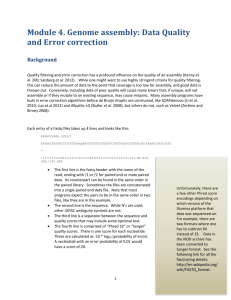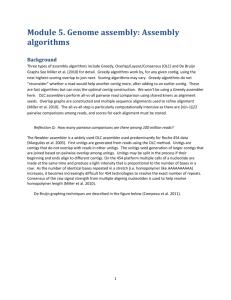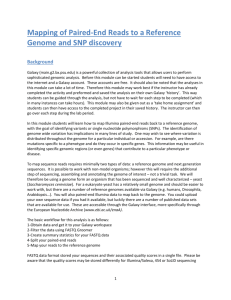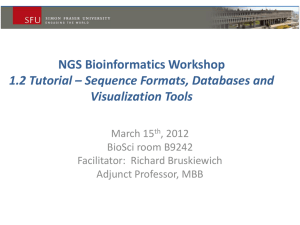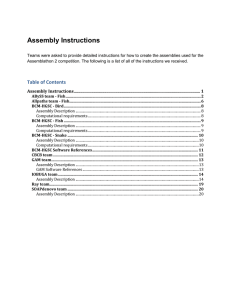QC and pre-assembly analyses
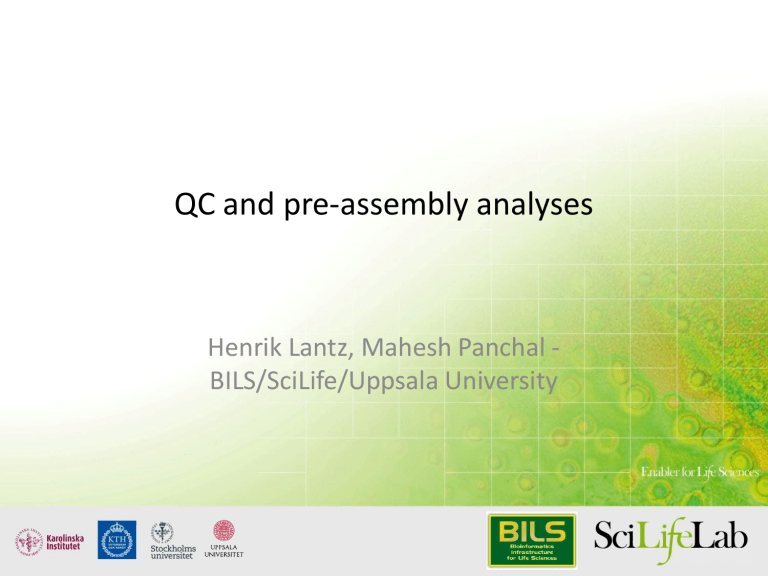
QC and pre-assembly analyses
Henrik Lantz, Mahesh Panchal -
BILS/SciLife/Uppsala University
Important organism specific properties
• Genome size
• Repeat content
• Heterozygosity
Important organism specific properties
• Genome size - Large genomes require more data whoch requires more time and is more complex to analyse
• Repeat content - Reads from different repeats are identical and confound the algorithms
• Heterozygosity - Assemblers usually try to create a haploid consensus assembly but will create double assemblies of heterozygotic regions
The devil is in the repeats
Mathematically best result:
C R A B
Repeat errors
Overlapping non-identical reads
Collapsed repeats and chimeras
Wrong contig order Inversions
Preparing reads for assembly
• Integrity and format validation
• Adapter removal
• (Error correction)
• Kmer analysis
• Contamination removal
Data integrity and format
• Many tools cannot tell if the data is complete.
• Transferred data should have checksums e.g MD5.
– 823fc8b0ca72c6e9bd8c5dcb0a66ce9b file1.fastq.gz
– $ md5sum -c md5.txt file1.fastq.gz: OK file2.fastq.gz: OK file3.fastq.gz: FAILED md5sum: WARNING: 1 of 3 computed checksums did NOT match
Data integrity and format
• Inspect your fastq files
– $ zcat file1.fastq.gz | head
@HWI-ST486:212:D0C8BACXX:6:1101:2365:1998 1:N:0:ATTCCT
CTTATCGGATCGATCCCAGTTTGGGCTTGTAAACGGTGAATCCTCAAAGACCACCAATGTTG
+
CCCFFFFFHHHHHJJJJJJHIJIIJGGJGFEGIGHIBFGHJIJIICHIIIDHGGIGIGHEFG
@HWI-ST486:212:D0C8BACXX:6:1101:2365:1998 2:N:0:ATTCCT
TAACCGAGCAAACAAAAGTTGGTTGTCACAAATTGTAATGACCTGATTAAACTTGATTTTTT
+
CCCFFFFFHHHHHJIIIJHIJJHIJJJJJJJJJJJIJJJIJJJJJIIIJJIJJJJGIJJJJH
– zcat lets you look at gzip compressed files and bzcat at bzip2 compressed files.
Basic inspection
• FastQC is a first step to diagnose major errors.
– $ module load bioinfo-tools FastQC/0.11.2
– $ fastqc -t 6 *.fastq.gz
Zhou and Rokas, 2014: Mol. Ecol.
FastQC
Zhou and Rokas, 2014: Mol. Ecol.
FastQC
Zhou and Rokas, 2014: Mol. Ecol.
Trimming adapters
• Adapter read-through is common.
– $ module load bioinfo-tools trimmomatic/0.32
– $ TRIMAPP= /sw/apps/bioinfo/trimmomatic/0.32/milou/trimmomatic.jar
– $ ADAPTERFILE=adapters.fasta
– $ java -jar $TRIMAPP PE –threads 16 \
Sample034_Lane1_R1.fastq.gz \
Sample034_Lane1_R2.fastq.gz \
Sample034_Lane1_R1.clean.fastq.gz \
Sample034_Lane1_R1.unpaired.clean.fastq.gz \
Sample034_Lane1_R2.clean.fastq.gz \
Sample034_Lane1_R2.unpaired.clean.fastq.gz \
ILLUMINACLIP:$ADAPTERFILE:2:30:10 \
LEADING:3 TRAILING:3 MINLENGTH:50
Detecting biases
• Do your fastq files contain the same information?
• Biases come from many sources
– Library preparation
– Contamination
– Machine error
Kmer analyses
Compute the frequency of each kmer in the dataset
Note: RAM-intense!
Kmer analyses module load bioinfo-tools KAT/2.0.6 gnuplot/4.6.5
OUTPUTDIR=$SNIC_TMP/kat_qc
PROJDIR=$(pwd) mkdir -p $OUTPUTDIR cd $OUTPUTDIR for FASTQ in $( find $PROJDIR -name “*.fastq.gz”); do gzip -c $FASTQ > $(basename ${FASTQ%.gz}) done kat hist -t 32 -C -o all_data_hist *.fastq
rm *.fastq
cd $PROJDIR rsync -av $OUTPUTDIR .
Reads vs kmers
1 read:
100 bp
Kmers: k=21bp
N= (L – k + 1)
(100bp – 21 bp + 1)
80
……..
Base coverage * (L-k+1) = Kmer coverage
L
Ex: 50X * (100-21+1) = 40X
100
(i.e. kmer coverage is 80% of base coverage)
Digging into the kmers
“Cpeak
20 million distinct kmers occure
55 times in all reads combined”
Genome size
• Remove low-copy kmers
• Identify the coverage peak
• Divide total nb of kmers by peak
Genome size = Ktot/Cpeak
Here:
1.4 Gbp = 80 G / 55
Note: Ktot = Nb reads * (L-k+1)
Base coverage = Cpeak
(L-k+1)/L
Here:
69X = 55
(100 – 21 +1)/100
Repeats: first shot
Single-copy
The nb of distinct kmers in the single-copy peak corresponds roughly to the single-copy genome size
Example
Beetle: 0.75 Gbp is single-copy, so almost
40% of the 1.2 Gbp genome is repeated
(kmer=27)
Repeats
Heterozygosity
Double peak in the kmer histogram; clear indication of heterozygosity
Not entirely easy to quantify (although attempts have been made)
Back to biases
• Do read 1 and read 2 have the same bias?
Kmer Analysis Toolkit: A short walkthrough
Bias detection and kmer analyses
• Do read 1 and read 2 have the same content?
Bias detection and kmer analyses
• Are all your runs/libraries affected in the same way?
Bias detection and kmer analyses
• Do your runs/libraries contain the same data?
Kmer analyses
# compare read 1 vs read 2 or lib A vs lib B
# Density plot kat comp -p -t 16 -C -D -o $OUTPUT $FWDREAD $REVREAD
# Spectra plot (must run density computation first) kat plot spectra-mx -n -o ${OUTPUT}_s.png $OUTPUT-main.mx
# Compare GC content kat gcp -t 16 -C -o $GCOUT $ALLREADS
Error correction and digital normalization
• Digital normalization removes high frequency reads
• Error correction removes low frequency reads
Estimating repeat content
• Create a de novo repeat library
– Run a low-coverage (e.g. 0.1X) assembly (e.g. RepeatExplorer or
Trinity)
– Filter contaminants and mito/chloro
– [ Make non-redundant (e.g. Cdhit) ]
– Quantify the (high) repeat content by an independent subset of reads
• Mapping (e.g. bwa), or
• Mask with RepeatMasker
Sparse seq data
Repeat library from low coverage data
R R R’ R R’’
Overlaps?
Sparse seq data
Repeat library from low coverage data
R R R’ R R’’
Overlaps?
Assembled contigs
Sparse seq data
Repeat library from low coverage data
R R R’ R R’’
Overlaps?
Assembled contigs
Warning! Beware of contaminations, plastids etc
Independent set of sparse data
R
Quantify your repeat seqs
R R’ R R’’
Screen reads with repeat seqs
33% of all bases in the reads are covered by repeat seqs
33% of the genome is “repeated”
Warning! The quantification depends heavily on the size of the original read set
Classifying repeats
Getting tricky…
LTR Gypsy/Copia
LINE/SINE
Classifying the repeat library directly
• RepeatMasker
DNA elements
…
• Repeat protein domain serach
( http://www.repeatmasker.org/cgi-bin/RepeatProteinMaskRequest )
Problems
• No close homologs in databases
• Rapid evolution of repeats (like transposable elements)
• Non-autonomous TE:s do not contain proteins
Solutions
• Fetch intact ORF:s from hits in assembly
• Extend assembly matches and get more complete elements
• Check match alignment profiles in assembly (LINES conserved at 3’ end but not at 5’..)
=> Often slow, manual, species-specific solutions
Take home
• Genome assembly is sometimes reasonably easy, if you are lucky and not too picky. There are tools to indicate which one you are up against.
• Filtering data is generally a necessity, but steps depend highly on input. Unless you use ALLPATHS-
LG, filter your data.
• Genome size and repeat content can (often better!) be estimated without an assembly
Thanks
